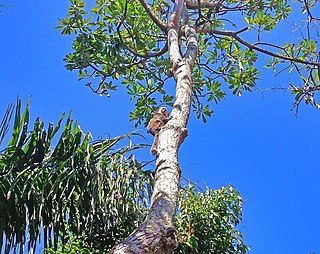
Orchids are plants that belong to the family Orchidaceae, a diverse and widespread group of flowering plants with blooms that are often colourful and fragrant.

Royal Botanic Gardens, Kew is a non-departmental public body in the United Kingdom sponsored by the Department for Environment, Food and Rural Affairs. An internationally important botanical research and education institution, it employs 1,100 staff. Its board of trustees is chaired by Dame Amelia Fawcett.
Genus is a taxonomic rank used in the biological classification of living and fossil organisms as well as viruses. In the hierarchy of biological classification, genus comes above species and below family. In binomial nomenclature, the genus name forms the first part of the binomial species name for each species within the genus.

The Arecaceae is a family of perennial, flowering plants in the monocot order Arecales. Their growth form can be climbers, shrubs, tree-like and stemless plants, all commonly known as palms. Those having a tree-like form are called palm trees. Currently, 181 genera with around 2,600 species are known, most of which are restricted to tropical and subtropical climates. Most palms are distinguished by their large, compound, evergreen leaves, known as fronds, arranged at the top of an unbranched stem. However, palms exhibit an enormous diversity in physical characteristics and inhabit nearly every type of habitat within their range, from rainforests to deserts.

The International Union for Conservation of Nature (IUCN) Red List of Threatened Species, also known as the IUCN Red List or Red Data Book, founded in 1964, is an inventory of the global conservation status and extinction risk of biological species. A series of Regional Red Lists are produced by countries and organizations, which assess the risk of extinction to species within a political management unit.

Hover flies, also called flower flies or syrphid flies, make up the insect family Syrphidae. As their common name suggests, they are often seen hovering or nectaring at flowers; the adults of many species feed mainly on nectar and pollen, while the larvae (maggots) eat a wide range of foods. In some species, the larvae are saprotrophs, eating decaying plant and animal matter in the soil or in ponds and streams. In other species, the larvae are insectivores and prey on aphids, thrips, and other plant-sucking insects.

Hibiscus is a genus of flowering plants in the mallow family, Malvaceae. The genus is quite large, comprising several hundred species that are native to warm temperate, subtropical and tropical regions throughout the world. Member species are renowned for their large, showy flowers and those species are commonly known simply as "hibiscus", or less widely known as rose mallow. Other names include hardy hibiscus, rose of sharon, and tropical hibiscus.

Plumeria, also known as frangipani, is a genus of flowering plants in the subfamily Rauvolfioideae, of the family Apocynaceae. Most species are deciduous shrubs or small trees. The species variously are endemic to the Neotropical realm, but are sometimes grown as cosmopolitan ornamentals in warm regions.

A botanical name is a formal scientific name conforming to the International Code of Nomenclature for algae, fungi, and plants (ICN) and, if it concerns a plant cultigen, the additional cultivar or Group epithets must conform to the International Code of Nomenclature for Cultivated Plants (ICNCP). The code of nomenclature covers "all organisms traditionally treated as algae, fungi, or plants, whether fossil or non-fossil, including blue-green algae (Cyanobacteria), chytrids, oomycetes, slime moulds and photosynthetic protists with their taxonomically related non-photosynthetic groups ."
An EPPO code, formerly known as a Bayer code, is an encoded identifier that is used by the European and Mediterranean Plant Protection Organization (EPPO), in a system designed to uniquely identify organisms – namely plants, pests and pathogens – that are important to agriculture and crop protection. EPPO codes are a core component of a database of names, both scientific and vernacular. Although originally started by the Bayer Corporation, the official list of codes is now maintained by EPPO.

An IUCN Red List Critically Endangered species is one that has been categorized by the International Union for Conservation of Nature as facing an extremely high risk of extinction in the wild. As of 2021, of the 120,372 species currently tracked by the IUCN, there are 8,404 species that are considered to be Critically Endangered.

Himatanthus obovatus is a species of genus Himatanthus in the family Apocynaceae, which is native Brazil, Bolivia, Guyana. It is common in Cerrado vegetation in Brazil. This plant is cited in Flora Brasiliensis by Carl Friedrich Philipp von Martius.

Himatanthus is a genus of flowering plant in the family Apocynaceae, first described as a genus in 1819. It is native to Panama and South America.
- Himatanthus articulatus(Vahl) Woodson - widespread from Panama east to French Guiana and south to Bolivia
- Himatanthus attenuatus(Benth.) Woodson - Venezuela, Colombia, N Brazil
- Himatanthus bracteatus(A.DC.) Woodson - Venezuela, Colombia, Guianas, Brazil, Peru, Ecuador
- Himatanthus drasticus(Mart.) Plumel - Guianas, Brazil
- Himatanthus lancifolius(Müll.Arg.) Woodson
- Himatanthus obovatus(Müll.Arg.) Woodson - Brazil, Bolivia, Guyana
- Himatanthus phagedaenicus(Mart.) Woodson - S Venezuela, NW Brazil
- Himatanthus semilunatusMarkgr. - Amazon Basin
- Himatanthus stenophyllusPlumel - Colombia, NW Brazil, Guyana, Suriname
- Himatanthus tarapotensis(K.Schum. ex Markgr.) Plumel - Colombia, Bolivia, Brazil, Peru, Ecuador
Himatanthus stenophyllus is a species of plant in the family Apocynaceae. It is native to Colombia, NW Brazil, Guyana, and Suriname.

A weed is a plant considered undesirable in a particular situation, growing where it is not wanted. The concept of weeds is particularly significant in agriculture, where the aim is growing crops or pastures of a single species, or a mixture of a few desired species. In such environments, other plant species are considered undesirable and therefore weeds. Besides, some weeds have undesirable characteristics making them a plant pest in most human settings.
The Plant List was a list of botanical names of species of plants created by the Royal Botanic Gardens, Kew and the Missouri Botanical Garden and launched in 2010. It was intended to be a comprehensive record of all known names of plant species over time, and was produced in response to Target 1 of the 2002–2010 Global Strategy for Plant Conservation, to produce "An online flora of all known plants". It has not been updated since 2013, and has been superseded by World Flora Online.

Isognathus menechus is a moth of the family Sphingidae.

Rauvolfioideae is a subfamily of the flowering plant family Apocynaceae. Many species are woody lianas, others are shrubs or perennial herbs.

World Flora Online is an Internet-based compendium of the world's plant species.















